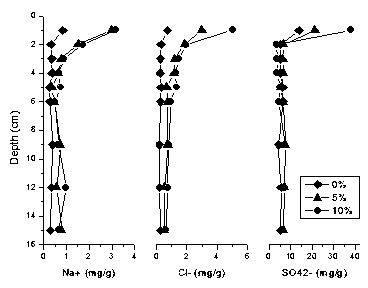Alkali-saline land productivity recovery method
A restoration method and productivity technology, applied in land preparation methods, soil lifting machinery, agricultural machinery and implements, etc., can solve the problem of consuming large water resources, save water resources, increase water holding capacity, and facilitate promotion.
- Summary
- Abstract
- Description
- Claims
- Application Information
AI Technical Summary
Problems solved by technology
Method used
Image
Examples
Embodiment 1
[0016] (1) Apply biochar to the soil at a depth of more than 30cm in the oasis farmland, and the application amount is 5% by weight; the application method is mixed application, that is, the biochar is evenly mixed with the soil.
[0017] (2) Plant crops, and use common field management methods such as irrigation, fertilization, and weeding to complete a round of crop planting and harvesting.
[0018] During this round of crop cultivation, due to the application of biochar, the Na in the soil + , Cl - and SO 4 2- Compared with the land without biochar application, the iso-salinization ion accelerates the enrichment to the soil surface above 2cm ( figure 1 ). This depth is above the rhizosphere layer of crops, so the enrichment of saline-alkali ions in this depth does not affect the normal growth of crops, but provides conditions for the removal of saline-alkali ions in the soil.
[0019] (3) Before the next round of crop planting, remove the soil layer at a depth of about...
Embodiment 2
[0022] (1) Apply biochar to the soil at a depth of more than 30cm in the oasis farmland, and the application amount is 10% by weight; the application method is mixed application, that is, the biochar is evenly mixed with the soil.
[0023] (2) Plant crops, and use common field management methods such as irrigation, fertilization, and weeding to complete a round of crop planting and harvesting.
[0024] During this round of crop cultivation, due to the application of biochar, the Na in the soil + , Cl - and SO 4 2- Compared with the land without biochar application, the iso-salinization ion accelerates the enrichment to the soil surface above 2cm ( figure 1 ).
[0025] (3) Before the next round of crop planting, remove the soil layer at a depth of about 2cm from the surface of the land, and then plant the crops.
[0026] The removed surface soil layer can be piled up separately. After accumulating to a certain amount, the saline-alkali ions can be removed by rinsing and re...
Embodiment 3
[0028] (1) Applying biochar to the soil at a depth of more than 15cm in the arid area farmland, the application amount is 5% and 10% by weight; the application method is mixed application, that is, the biochar is evenly mixed with the soil;
[0029] (2) To plant crops, use the soil moisture controller to perform precise irrigation according to the optimal soil moisture content required by the crops, and cooperate with other common field management methods such as fertilization and weeding to complete a round of crop planting and harvesting.
[0030] During this round of crop cultivation, due to the application of biochar, the Na in the soil + , Cl - and SO 4 2- The iso-salinization ions are accelerated and enriched to the soil surface above 2cm, which also produces similar figure 1 The results shown.
[0031] (3) Before the next round of crop planting, remove the soil layer at a depth of about 2cm from the surface of the land, and then plant the crops.
[0032] The remove...
PUM
| Property | Measurement | Unit |
|---|---|---|
| Depth | aaaaa | aaaaa |
Abstract
Description
Claims
Application Information
 Login to View More
Login to View More - R&D
- Intellectual Property
- Life Sciences
- Materials
- Tech Scout
- Unparalleled Data Quality
- Higher Quality Content
- 60% Fewer Hallucinations
Browse by: Latest US Patents, China's latest patents, Technical Efficacy Thesaurus, Application Domain, Technology Topic, Popular Technical Reports.
© 2025 PatSnap. All rights reserved.Legal|Privacy policy|Modern Slavery Act Transparency Statement|Sitemap|About US| Contact US: help@patsnap.com

